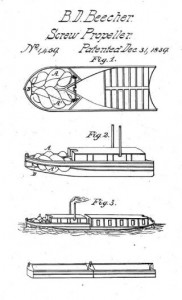Benjamin Dutton Beecher was a millwright and machinist with a knack for invention. Described by some as “eccentric,” Beecher lived a modest life in Prospect in an 8-sided house of his own design. While credited with developing numerous inventions, the two for which he received the greatest acclaim are his grain harvesting fanning mill and his screw-operated steamboat propeller.
Beecher’s fanning mill machine followed in the footsteps of similar machines patented by men like Thomas S. Barnum of Sharon in 1812 and Joel Soper of Windsor in 1814. The idea behind the fanning mill was to use strong air currents to separate grain from chaff after the harvest.
Fanning Mill Speeds Grain Processing
Prior to the fanning mill, farmers brought harvested grain stalks into barns to be trampled by horses or have sledges (carriages on runners) drawn over them in order to separate the valuable grain from the rest of the plant. The labor-intensive process then required the grain to be tossed into the air from a winnowing pan where the wind blew away any remaining chaff. The fanning mill greatly increased productivity by automating the cleaning of coarse grains such as wheat, oats, and barley for consumption. Beecher patented his machine on May 30, 1816, receiving praise for its contribution to the evolution of modern farming.
The other significant contribution Beecher made to technological advancement in the 19th century was eclipsed by later, more successful designs. Beecher worked for a year on developing a screw propeller for steamboats. Like others in the US and Europe during this time, he sought to replace the steamship’s cumbersome paddlewheel with a less bulky form of propulsion better suited to the constraints of canals and less vulnerable to attack in military engagements. A test of the device at nearby Juggernaut Pond gave him confidence to try his invention out on the Farmington Canal. Beecher arranged for a team of oxen to drag his boat from its construction site in the western part of town over to the canal at Beachport in Cheshire. Among the passengers on this 1830s test voyage was Connecticut Governor and Cheshire native, Samuel A. Foot. The experimental craft made it as far as Hamden before ultimately failing and forcing its passengers to return to Cheshire on foot. Another account, likely of a different trial run, has the vessel journeying 4 miles north and successfully back to Beachport. This inspired Governor Foot’s son, US Navy Lieutenant Andrew Hull Foote (who added an “e” to his surname and later became an admiral celebrated for his Civil War service) to call for additional experimentation. So, around 1840, Beecher outfitted and sent a boat to the Erie Canal for that purpose. Ultimately Beecher’s innovation, which employed a single screw-propeller, did not advance beyond the trial phase but his design may well have inspired others on to success.
Beecher’s dedication to invention resulted in a modest existence, as much of his income went into developing prototypes for his various ideas. As a result, by the time of his death in 1866, Beecher’s list of inventions included an automatic button maker, an endless band saw, and an automated water feeder for steam boilers. None of these inventions, however, matched the critical acclaim Beecher received for the progress he made in furthering grain production and water transportation with his fanning mill and screw-propeller ideas.










